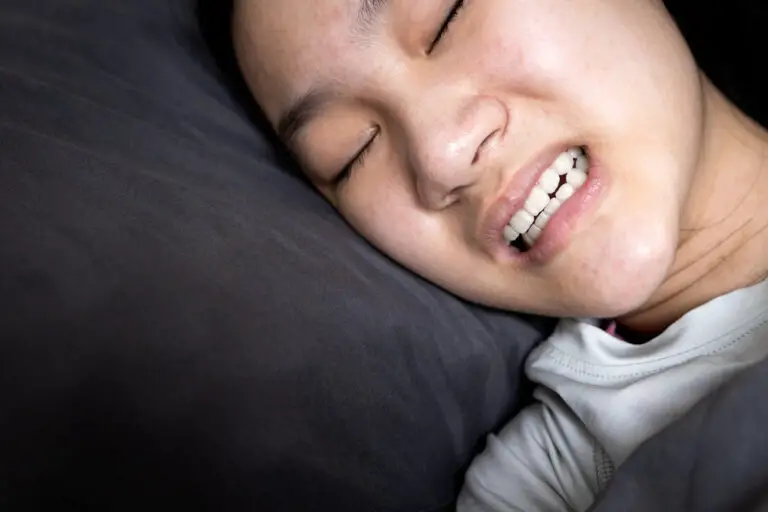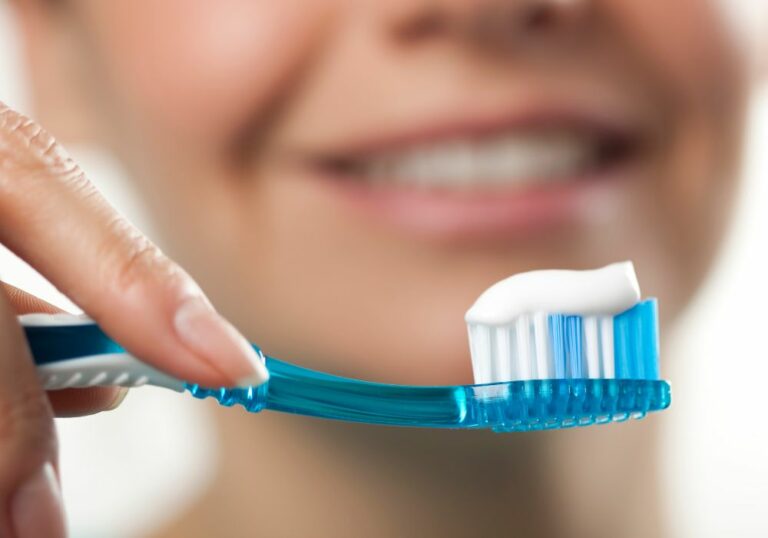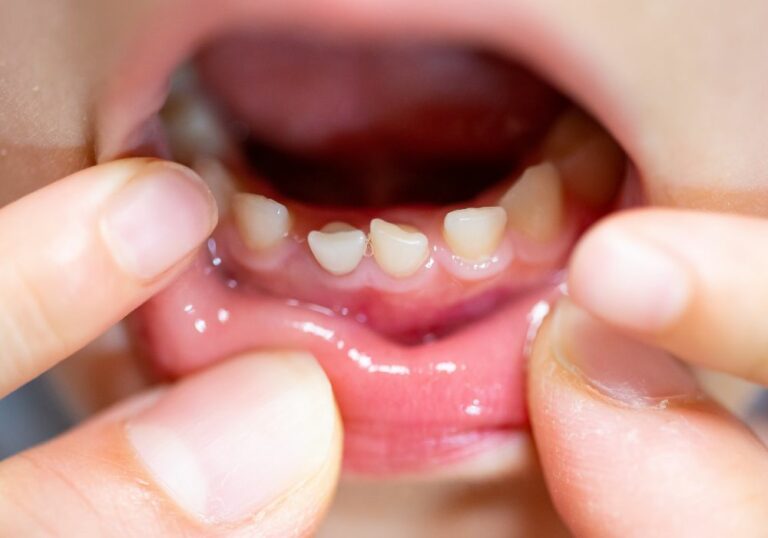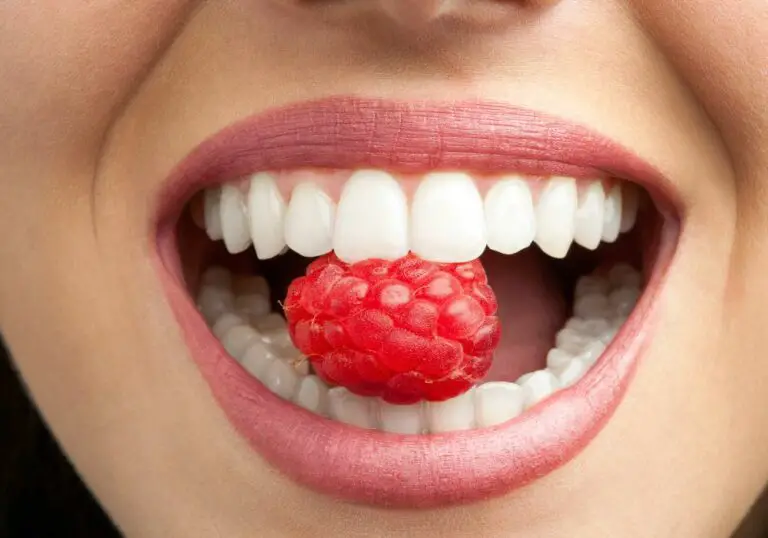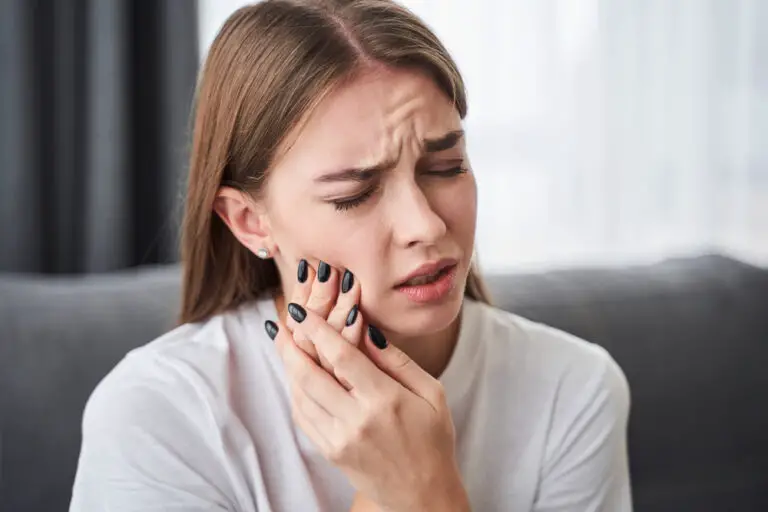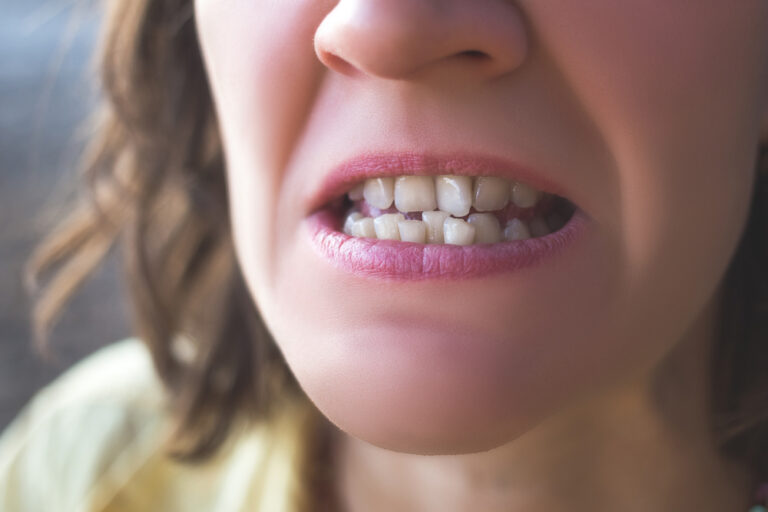Teeth are naturally off-white in color. Pure white teeth are not natural for most people. The natural shade of teeth ranges from light yellowish-white to greyish-white. Very few people have brilliant white teeth without any artificial whitening treatments.
The main structural component of teeth is dentin. Dentin is a yellowish material that lies underneath the enamel that covers the tooth crown. The color of dentin is one factor that affects the natural shade of teeth. The thicker the enamel, the whiter the teeth will appear. Thinner enamel allows more of the yellowy dentin color to show through.
What causes natural tooth discoloration?
There are several reasons why teeth naturally tend toward off-white colors rather than pure white:
Age
Enamel thins over time allowing more dentin to show through. Older teeth appear more yellow as enamel thickness decreases with age. Enamel can thin at a rate of up to 0.8 millimeters over a lifetime.
Genetics
Some people inherit enamel that is thicker and more opaque, giving them a whiter natural tooth color. Enamel thickness is primarily determined by genetics and can vary from 0.1 to 2.5 mm. Increased enamel thickness and mineralization leads to greater opacity and whiteness.
Fluorosis
Overexposure to fluoride during tooth development can cause enamel fluorosis, resulting in opaque white spots or streaks. Fluorosis causes uneven enamel thickness and porosity, which can make teeth appear less white overall due to scattered areas of opacity.
Medications
Some drugs taken by children while teeth are developing may cause discoloration years later when the adult teeth erupt. Tetracycline antibiotics are a common culprit, binding to calcium ions in developing enamel and dentin. Other drugs like antihistamines, anti-inflammatories, and anti-cancer drugs can also cause staining.
Trauma
Injuries to teeth can damage the enamel through fractures or cracks, allowing dentin to show through. Enamel damage from falls, sports injuries, biting hard objects, or trauma from braces or tools can lead to discoloration.
Developmental conditions
Enamel may not fully or evenly develop on all teeth for some people due to genetic diseases like amelogenesis imperfecta or environmental factors. Weak, thin enamel results in a yellowed appearance.
Internal discoloration
Discoloration inside the tooth itself can also affect the natural color. There are a few sources of internal discoloration:
Pulp necrosis
If the pulp tissue inside the tooth dies due to trauma, caries, or infection reaching the pulp chamber, the tooth may darken over time. Pulp necrosis allows blood components to leach into the surrounding dentin, causing amber discoloration.
Intrinsic stains
Yellowish pigments from chromogenic food and drinks can seep into the porous enamel over time, especially after enamel defects occur. Staining of dentin is permanent once it occurs.
Dental caries
Tooth decay allows stains to reach the dentin layer, causing discoloration. Caries remove the protective enamel layer, exposing the yellow dentin underneath. Advanced decay turns teeth dark brown or black.
Restorations
Dental fillings, especially older silver amalgam fillings, can give teeth a dark appearance. Metal alloys in amalgam restorations cause graying of surrounding tooth structure.
Extrinsic stains
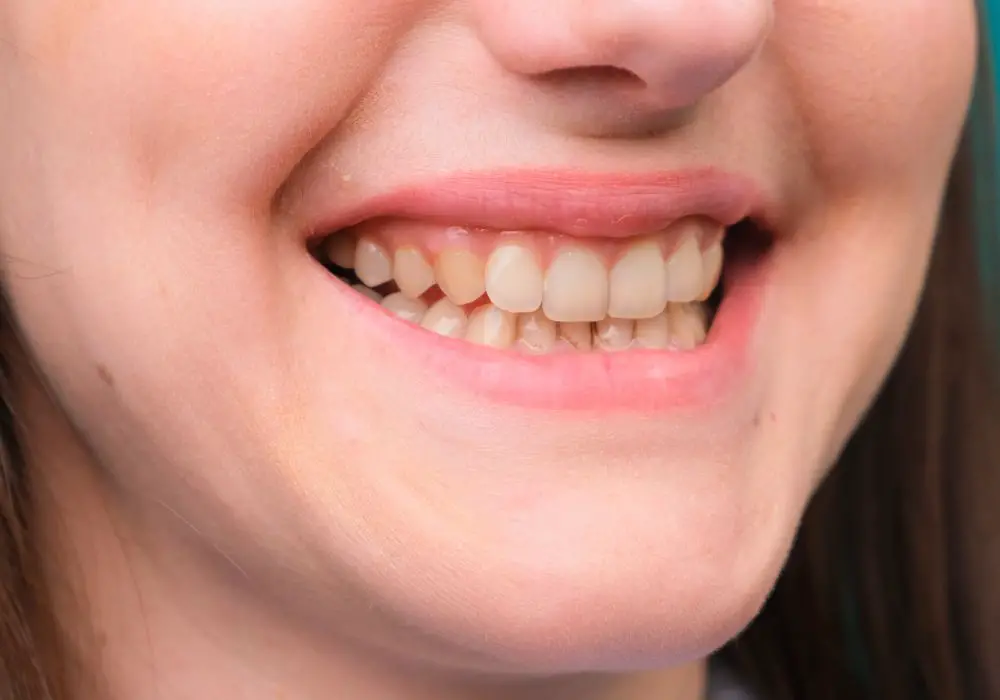
External stains that form on the tooth surface can also affect the natural color:
- Plaque and calculus – These sticky dental deposits trap stains near the gumline, causing yellowish tartar deposits. Plaque also harbors chromogenic bacteria that produce pigments.
- Tobacco use – Chewing tobacco and smoking cause brownish-yellow stains on the teeth and oral mucosa. Tar and nicotine byproducts permanently stain enamel when teeth come in repeated contact.
- Poor oral hygiene – Inadequate brushing and flossing leads to buildup of staining plaque. Plaque left longer than 48 hours calcifies into tarter, which binds strongly to stains.
- Chromogenic bacteria – Some bacteria like Actinomyces produce pigments as metabolic byproducts that can stain teeth. The pigment ferritin especially contributes to black stain with prolonged biofilm accumulation.
- Metallic compounds – Rusty iron in well water or trace metals in medications can oxidize and leave reddish-brown discoloring deposits on teeth. Copper in water or dental materials is another culprit.
- Foods/drinks – Soy sauce, berries, soda, wine, and coffee contain tannins, acids, and other chromogens that stain enamel over time. The acidic nature of these also erodes enamel to enhance staining.
Is natural tooth color linked to health?
The natural shade of teeth is not necessarily an indicator of oral health. While severe discoloration can be a sign of decay, mild tooth color variation is normal. Many people have off-white teeth due to genetics and age but still have healthy teeth. Whiteness is not a reliable measure of tooth health.
However, good oral hygiene and avoiding stain-causing foods/drinks helps prevent discoloration and decay. Regular dental cleanings also remove stains from the tooth surface. A healthy diet with enamel-strengthening vitamins like A, C, and D, and minerals like calcium and phosphorous, will keep teeth strong regardless of shade.
Can natural tooth color change over time?
Yes, natural tooth color tends to darken gradually over time. New adult teeth are often whiter due to having thicker, newly mineralized enamel. As we age, external stains build up and enamel thins at a rate of up to 0.8 mm across a lifetime, revealing more yellow dentin. Teeth also become less porous over time due to sclerosis of the enamel, preventing stains from escaping once they penetrate the enamel layer.
Trauma and restorations that damage enamel also accelerate discoloration. Endodontic treatment to remove the pulp makes teeth appear darker. A dead, empty pulp chamber lacks the natural translucency and light reflection of a vital pulp. Pulpal hemorrhage into dentin from trauma can also cause severe darkening.
However, long-term use of whitening toothpastes and other treatments can gradually lighten stained teeth again by up to two shades. Avoiding smoking, coffee, tea, and red wine will also help prevent further discoloration due to intake of chromogens.
Can diet and oral hygiene affect natural tooth color?
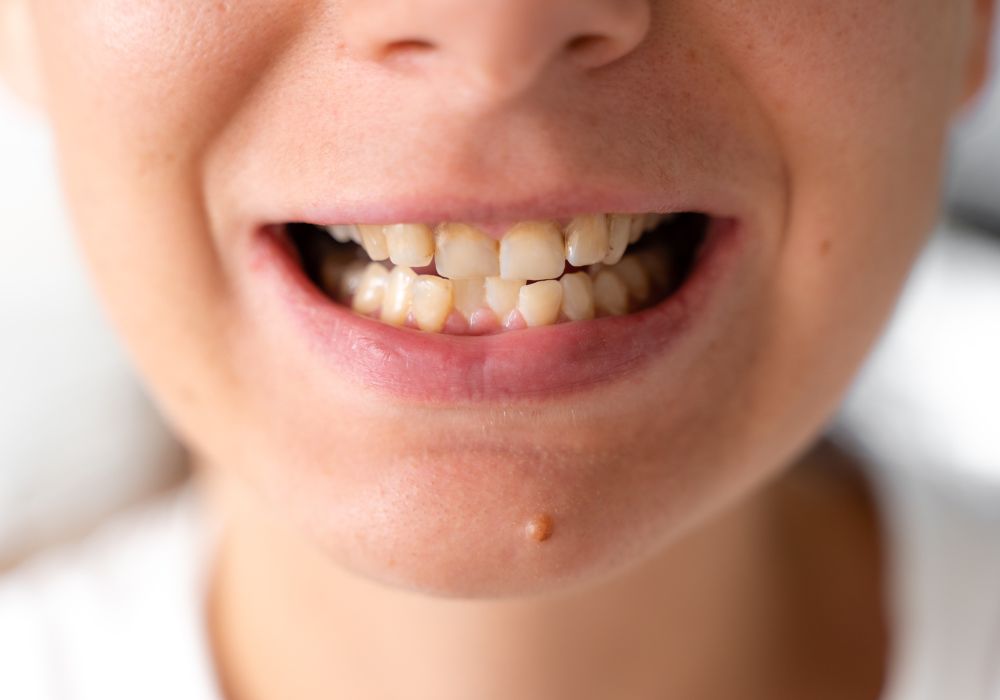
Yes, diet and oral hygiene habits can impact the natural shade of teeth to some degree:
- Avoid stain-causing foods/drinks – Coffee, tea, cola, red wine, berries, and tobacco will discolor teeth over time. These contain tannins, acids, and other chromogens that bind to enamel. Minimizing intake will help maintain a whiter color.
- Eat teeth-whitening foods – Crunchy fruits and vegetables help scrub stains away through friction. Pineapple contains the enzyme bromelain which breaks down plaque. Apples, celery, and carrots also physically cleanse teeth.
- Brush and floss – Prevent plaque buildup by brushing twice and flossing once daily. Brushing removes extrinsic stains before they can permeate the enamel. Flossing clears interdental plaque.
- Use whitening toothpaste – Most major brands contain gentle abrasives like silica or calcium carbonate to physically scrub stains. Many also include chemical cleansers like hydrogen peroxide to further brighten teeth.
- Get professional cleanings – Dental hygienists remove hardened calculus deposits that trap extrinsic stains using scaling and polishing tools. Regular prophylaxis appointments every 6 months prevent discoloration.
- Drink fluoridated water – Fluoride strengthens and protects enamel to resist staining. Drinking fluoridated water and using fluoride toothpaste helps toughen enamel against chromogens.
- Take recommended supplements – Vitamins C and D improve enamel strength, while calcium and phosphorous aid remineralization. A multivitamin provides enamel-fortifying nutrients.
Good oral care and smart food choices will keep teeth at their natural whitest. However, only advanced whitening treatments can alter the intrinsic color of teeth substantially beyond their natural shade.
Typical natural tooth shade variation
There is a wide range of natural tooth colors, which are categorized by shade guides like VITA Classical and VITA System 3D-Master. These shade guides have multiple tabs spanning the normal range of natural tooth shades, from light yellow-white to grayish shades.
Some examples of common natural tooth shades are:
- A1 – Light yellowish-white, one of the lightest natural shades
- A2 – Yellowish-white, a common shade for younger teeth
- A3 – Yellow-gray white, a median shade
- A3.5 – Yellow-gray white, leaning toward the darker end
- A4 – Gray-yellow white, darker yellow tones
- B3 – Gray-yellow white, touching into gray hues
- C2 – Grayish-white, a common older tooth shade
- C3 – Mildly grayish, a darker natural shade
- D3 – Gray-brown white, a very dark natural shade
In general, younger teeth will be in the whiter A and B shade range, ranging from light yellow to subtle gray. Older teeth tend to be C and D shades with more prominent gray and yellow-brown undertones. Very few individuals will have brilliant A1 “Hollywood white” teeth without whitening treatments. Natural tooth color for most people varies within the A2 to C3 range.
Tooth shade guides
Dentists use porcelain shade guides to evaluate tooth color and changes during whitening treatments. Shade tabs are arranged by hue (principal color) and chroma (saturation level). Common shade guides include:
- VITA Classical – 16 tabs from B1 to D4. Utilizes a basic A-D letter scale.
- VITA 3D Master – 26 tabs across 5 hue groups from lightest to darkest. Allows for precise custom shade matching.
- Chromascop – 20 tabs across 4 hue groups from yellow-red to gray. Includes effect tabs like translucency.
- TruMatch – 37 tabs providing small gradations across a wide color range. Simplified letters and numbers naming system.
These standardized shade guides allow dentists to identify the closest matching shade to a patient’s teeth, assessing all factors like chroma, hue, and translucency. Digital image analysis is also emerging for advanced computer shade matching. Understanding natural tooth color categories enables dentists to better evaluate shade and customize whitening techniques.
Are white crowns and fillings better than natural shade?
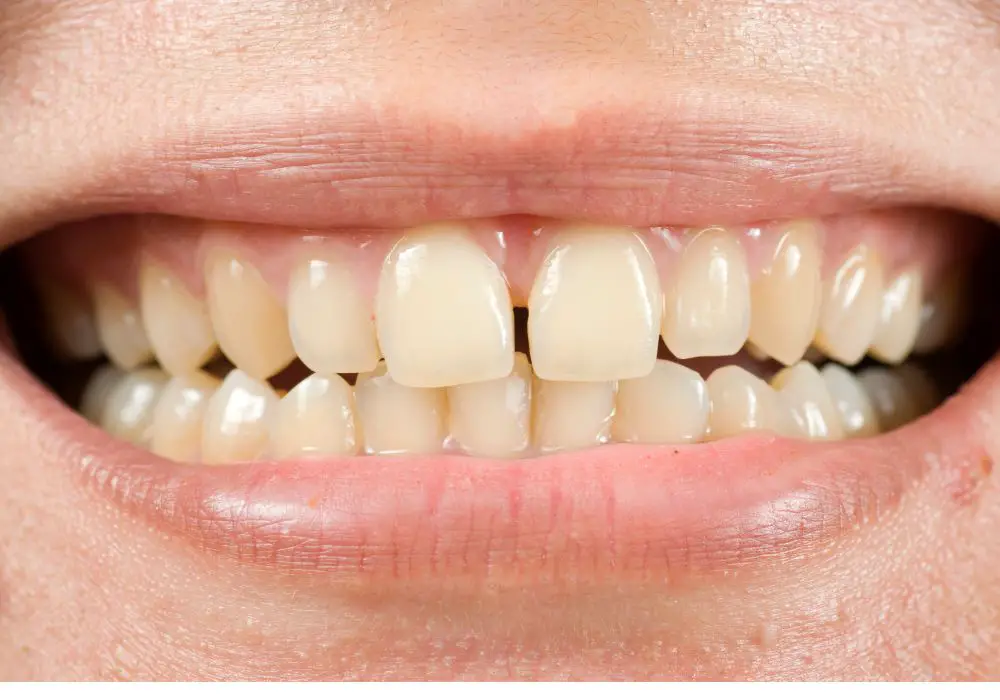
Porcelain dental restorations like crowns and veneers can be fabricated in very white shades to create a bright smile. However, restorations that are too starkly white compared to the natural teeth can sometimes look unnatural.
Matching the color of fillings and crowns to the natural tooth shade results in a more seamless, natural looking smile. Whiter artificial teeth surrounded by yellower natural teeth may give a “chicklet” look. A whiteness difference of more than 2-3 shades of the shade guides is usually considered too high of a contrast with natural teeth.
On the other hand, going slightly whiter than the natural shade can make teeth appear brighter and more youthful. A difference of 1-2 shades lighter than the natural teeth can give a subtle whitening effect while still looking natural. The goal is a minimal variation that brightens the smile without looking obviously artificially white.
FAQ
Can I brush my teeth too much to make them whiter?
Brushing too vigorously or too frequently can actually damage enamel and enhance staining. Enamel can be abraded by excessive brushing, causing gradual thinning that reveals more yellow dentin. Light brushing twice per day with gentle whitening toothpaste is sufficient for mildly whitening teeth through stain removal and abrasion. Overbrushing also leads to dentin exposure and sensitivity.
Why do some people have naturally whiter teeth?
Genetics play a big role in the natural shade of teeth. Some individuals inherit thicker, more opaque enamel that resists staining. Enamel thickness, mineral content, and smoothness vary widely by genetics, impacting natural whiteness. Ethnic background also impacts tooth shade, with those of European descent generally having lighter teeth than other ethnicities on average.
Can whitening treatments damage teeth?
Overuse of peroxide-based whitening gels at very high concentrations can potentially cause enamel erosion in some cases. Improper application methods can also lead to gum irritation when whitening products contact soft tissues. However, when properly prescribed and applied by a dentist, whitening treatments are generally quite safe for most patients. Over-the-counter products with very high peroxide levels carry greater risks.
How do cigarettes and chewing tobacco stain teeth?
Tobacco products contain large amounts of staining substances like tar, nicotine, and other polycyclic hydrocarbons that deposit on tooth surfaces. Staining occurs through both direct contact and recirculation of pigments in saliva. Tobacco stains can permeate enamel pores within minutes of exposure. Stains mostly accumulate in pit and fissure surfaces. Giving up tobacco is the only way to reliably reverse this type of discoloration.
Why do older teeth appear more yellow?
As we age, enamel naturally thins due to use, dropping from 2.5mm thick to as little as 0.8mm over a lifetime. Thinner enamel reveals more yellow dentin color underneath. Enamel also loses some mineral content over time, becoming more transparent. Small enamel pores also close up with age due to sclerosis, trapping existing stains. These cumulative changes associated with aging all contribute to a more yellowed appearance of older teeth.

